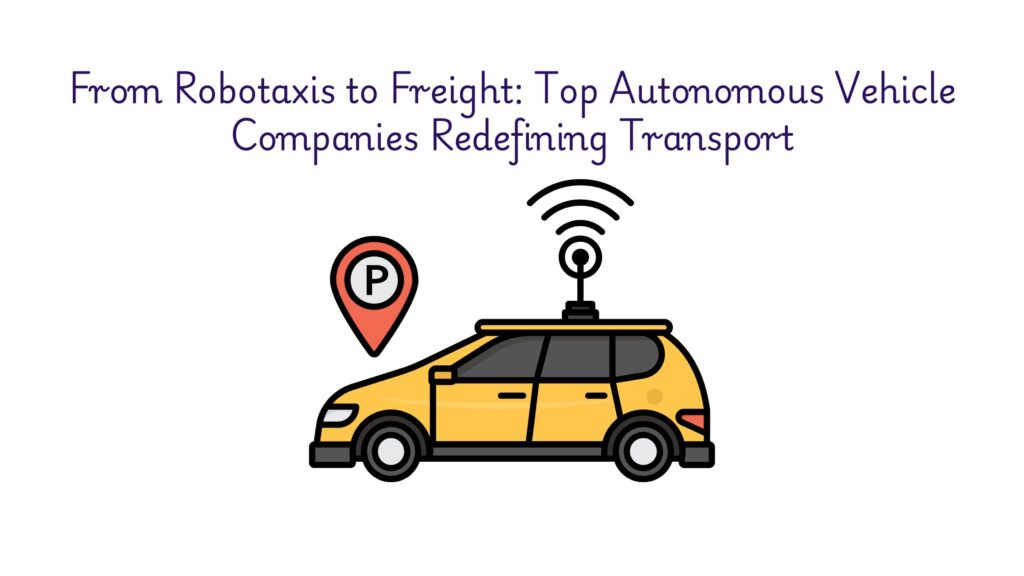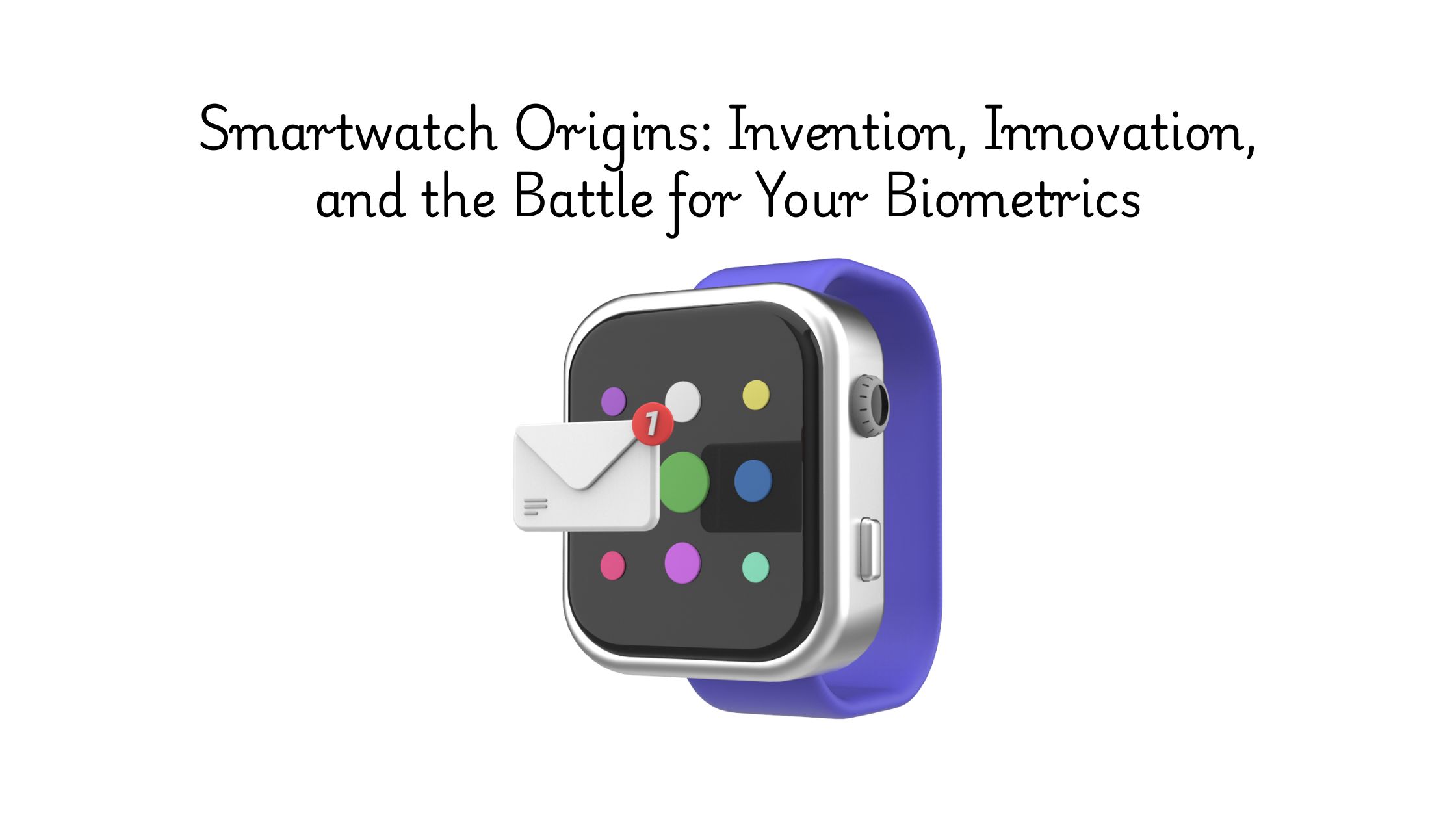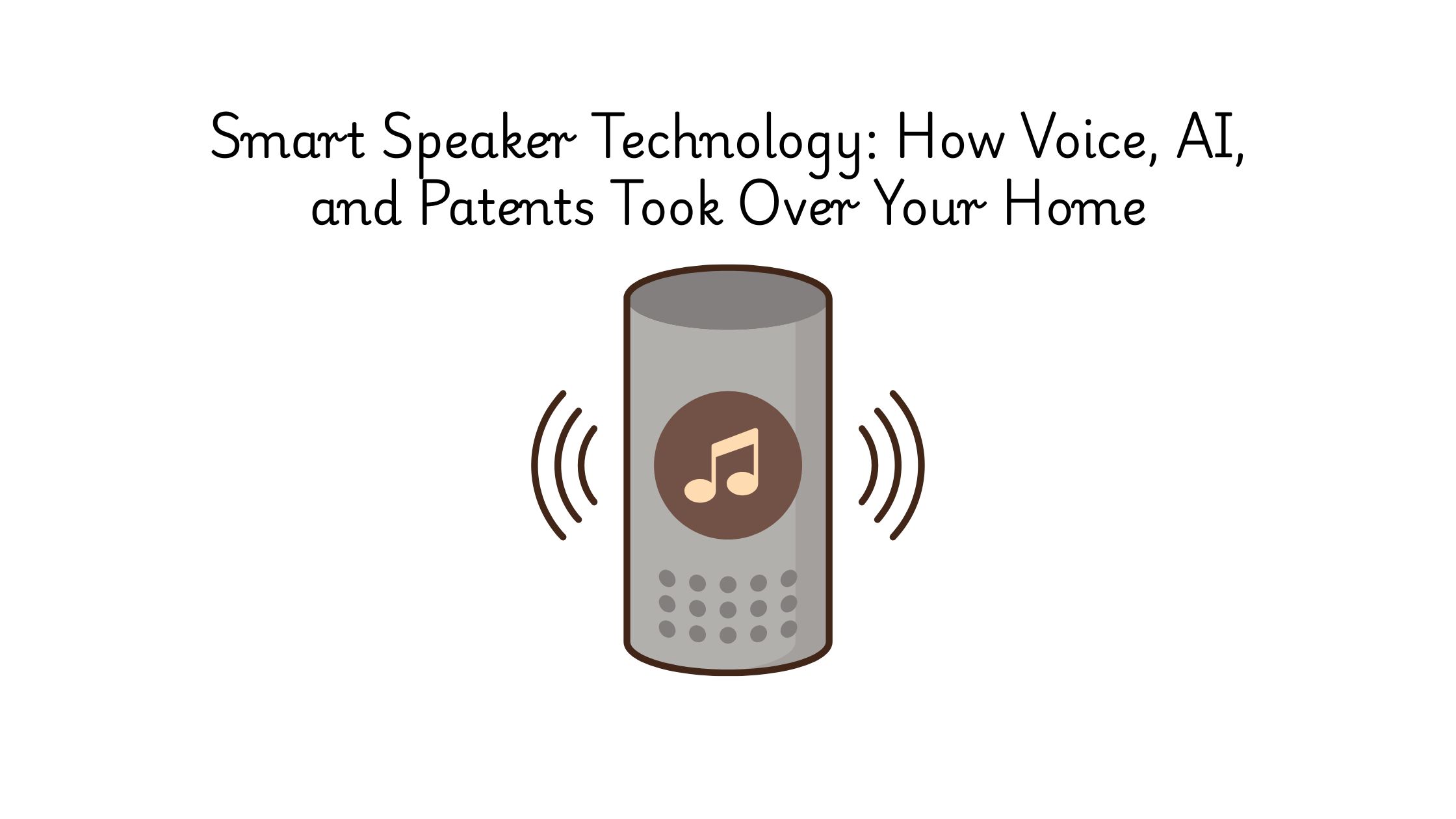Autonomous vehicles have moved from lab prototypes to live deployments in cities around the world. The global autonomous vehicle market is expected to grow from $63.6 billion in 2024 to $186.4 billion by 2030, at a CAGR of 20.3%. From self-driving trucks and robotaxis to delivery bots, the future of transport is being rewritten in real-time.
But here’s the truth: not every company talking about autonomy is actually building it. Real innovation comes from those solving the hard problems – sensor fusion, real-time decision-making, edge AI, and safety at scale.
In this article, I’m sharing 20 companies truly pushing the boundaries of autonomous vehicle technology. These are the ones filing patents, raising capital, launching fleets, and driving the industry forward.
Let’s explore who’s shaping the future of mobility.
#1. Waymo
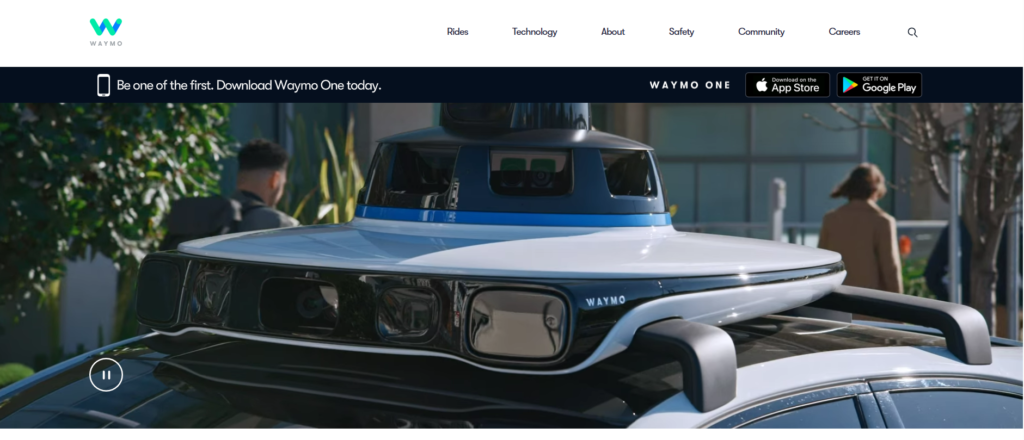
Source: Waymo
Waymo started as Google’s self-driving car project back in 2009, and today, it’s arguably the most advanced autonomous vehicle company on the planet. It was the first to launch a fully driverless robotaxi service with no safety driver in real cities like Phoenix and San Francisco.
Their in-house platform, Waymo Driver, fuses LiDAR, radar, vision, and neural networks to navigate chaotic urban environments in real-time. With 1,500+ patents and 20+ billion miles in simulation and real-world testing, Waymo has built the most proven autonomy stack in the industry.
Industry Impact
Waymo is transforming urban mobility, logistics, and last-mile delivery. Through partnerships with ride-hailing platforms, automotive OEMs, and retail delivery companies, it’s building a new category of driverless transport that serves both passengers and goods.
Key Innovations
Waymo Driver: Waymo Driver is a fully autonomous driving system that combines LiDAR, radar, cameras, and deep learning to understand and navigate complex road environments. It processes data from its sensors in real time to make safe driving decisions across a wide range of traffic scenarios, including unprotected left turns and pedestrian-heavy zones. The system has been trained on billions of miles, both simulated and real, making it one of the most tested AV platforms in the world.
Waymo One: Waymo One is the world’s first fully driverless commercial robotaxi service, currently operating in Phoenix and San Francisco without safety drivers. Users can hail a ride through an app, and the vehicle autonomously picks them up and drops them off, just like a traditional ride-hailing service. What sets Waymo One apart is its consistent performance in high-density urban settings, proving that driverless mobility is not just a demo; it’s a functioning business.
#2. Cruise
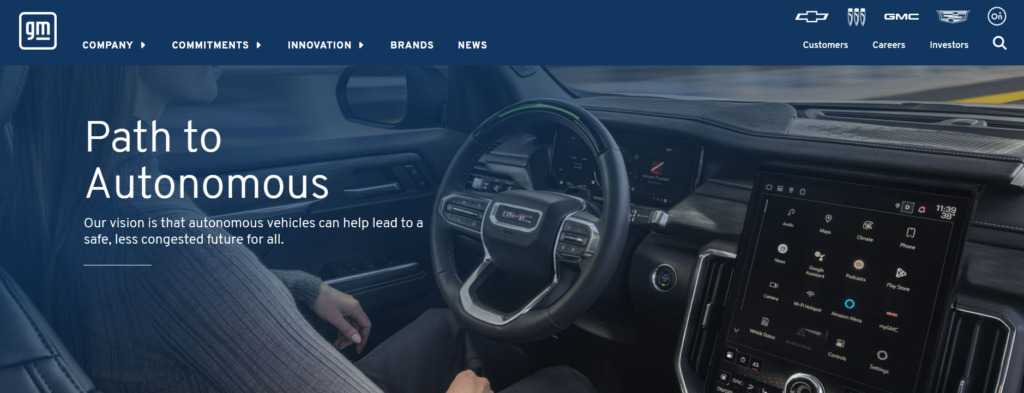
Source: getcruise
Cruise, a subsidiary of General Motors, is one of the few companies operating fully driverless vehicles in dense urban areas like San Francisco without a human behind the wheel. What sets Cruise apart is its commitment to electrification from day one: every vehicle in its fleet is 100% electric. Cruise’s flagship, the Origin, is a purpose-built, steering-wheel-free robotaxi designed for autonomy, not just retrofitted for it. Backed by GM, Honda, Microsoft, and Walmart, Cruise controls its full tech stack, including sensors, simulation, and vehicle platforms.
Cruise also holds over 700 patents on autonomous navigation, sensor fusion, and decision-making systems (source: IFI CLAIMS, 2024), reinforcing its position as a true tech innovator, not just a systems integrator.
Industry Impact
Cruise is reshaping ride-hailing and urban transportation through robotaxi deployments and delivery pilots. It’s also expanding into autonomous last-mile logistics, working with major retailers to enable self-driving grocery and parcel delivery.
Key Innovations
Cruise AV: Cruise AV is an all-electric autonomous vehicle built specifically for urban environments, using a multi-sensor setup and AI-driven decision systems to navigate dense traffic. It’s been trained to handle complex city scenarios like four-way stops, cyclists, and pedestrians in unpredictable movement patterns. The vehicle is designed to operate safely without a human driver, and it is currently running in San Francisco with no one behind the wheel.
Cruise Origin: The Cruise Origin is a purpose-built, fully autonomous vehicle with no steering wheel or pedals, designed from the ground up for shared, driverless mobility. Its symmetrical design and spacious cabin optimize passenger comfort while supporting bi-directional movement. Backed by GM and Honda, the Origin reflects Cruise’s vision of a safer, electric-first, and scalable transportation future.
Cruise OS: Cruise OS is the software backbone that powers the company’s autonomous vehicles, integrating everything from perception and localization to planning and control. It continuously processes massive streams of real-time sensor data to make driving decisions, react to edge cases, and ensure safety in unpredictable environments. What makes Cruise OS powerful is that it’s developed entirely in-house, allowing tight integration between the software, vehicle hardware, and remote fleet management systems.
#3. Aurora Innovation
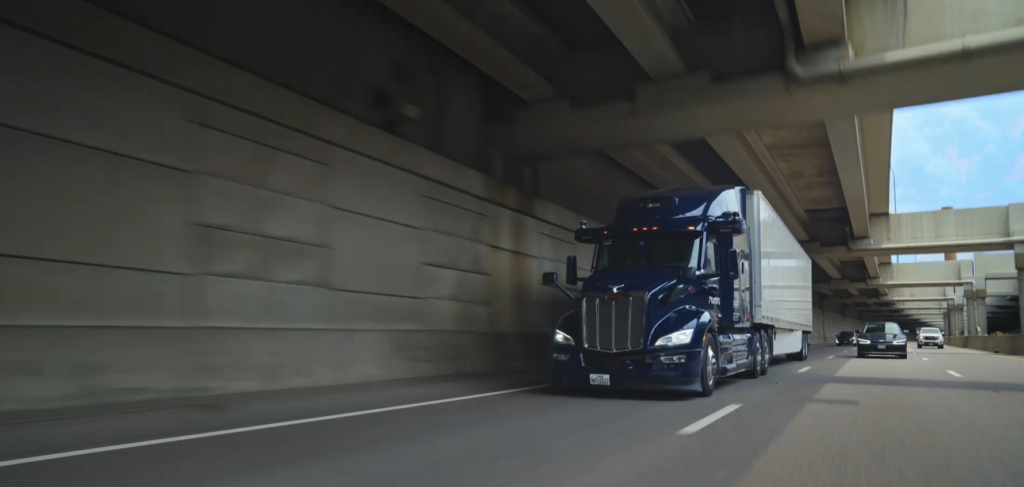
Source: Aurora
Aurora Innovation is tackling autonomy where the stakes are highest: long-haul trucking. Founded by veterans from Google, Tesla, and Uber’s AV teams, Aurora is building a full-stack autonomous driving system called Aurora Driver, with a laser focus on freight and logistics. Rather than chasing ride-hailing, Aurora is betting big on self-driving trucks as the most immediate path to scalable revenue.
Aurora has accumulated 400+ patents and patent applications related to sensor technology, motion planning, and autonomous control systems (source: USPTO and Aurora IR filings, 2024). Its strategic acquisitions, like lidar startup Blackmore and Uber’s ATG, have deepened its IP moat and accelerated commercialization.
Industry Impact
Aurora is transforming the freight and logistics sector by enabling autonomous trucking across major U.S. corridors. Through partnerships with FedEx, PACCAR, and Volvo, it’s actively piloting autonomous deliveries and working toward fully driverless freight operations.
Key Innovations
Aurora Driver: Aurora Driver is a flexible autonomy platform designed to operate across multiple vehicle types: trucks, passenger cars, and delivery vans. It uses a fusion of LiDAR, radar, cameras, and Aurora’s proprietary perception and planning systems to handle highway and urban environments. The modular design allows it to be integrated with different OEM vehicle partners, making it scalable across freight and mobility sectors.
FirstLight LiDAR: FirstLight LiDAR is Aurora’s proprietary sensing technology that measures both the distance and velocity of objects, enabling more accurate motion prediction. Unlike traditional LiDAR, it uses frequency-modulated continuous wave (FMCW) technology to detect small, fast-moving objects at long range, even in bad weather. Aurora’s vehicles have a crucial advantage regarding high-speed, long-range perception for highway driving.
Virtual Testing Suite: Aurora’s Virtual Testing Suite simulates millions of driving scenarios, including rare edge cases, to train and validate its autonomy stack. It enables engineers to test new software builds rapidly without putting vehicles on the road, saving time and reducing risk. This approach accelerates learning cycles and ensures safety before new updates are deployed in real-world fleets.
#4. Mobileye
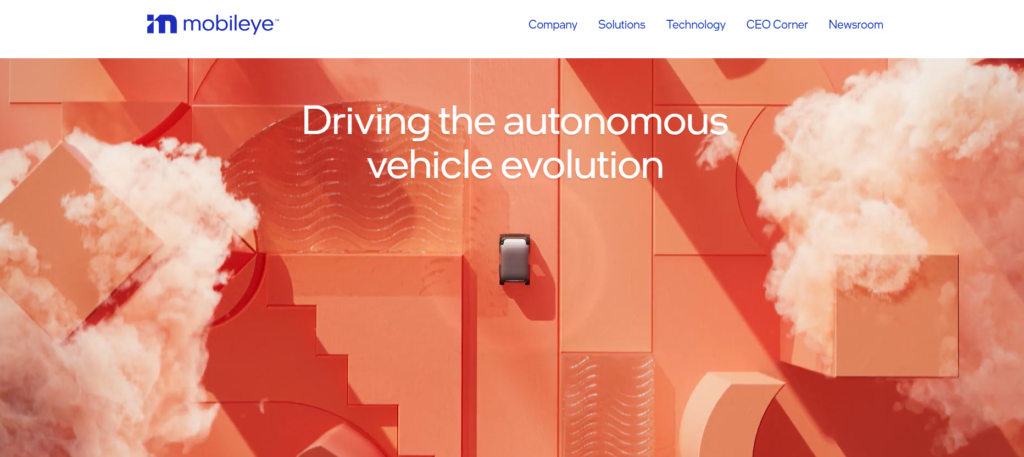
Source: Mobileye
Mobileye, an Intel company based in Israel, is one of the most commercially deployed names in autonomous driving. While many focus on fully driverless vehicles, Mobileye has taken a layered approach, offering advanced driver-assistance systems (ADAS) to millions of cars on the road today while developing a fully autonomous stack in parallel. Their AV platform, Mobileye Drive, is built on their proprietary EyeQ chips, REM (Road Experience Management) mapping tech, and a vision-centric AI system.
With over 2,400 patents worldwide (source: IFI CLAIMS, 2024), Mobileye is one of the most IP-rich companies in the space. Its strength is bridging today’s assisted driving with tomorrow’s full autonomy while already generating meaningful revenue from global OEM integrations.
Industry Impact
Mobileye is transforming both personal mobility and commercial fleets. It powers ADAS in vehicles from brands like BMW, Volkswagen, and Ford and is rolling out autonomous vehicle pilots in cities across Israel, Germany, and the U.S.
Key Innovations
Mobileye Drive: Mobileye Drive is a turnkey autonomous driving system designed for both passenger vehicles and commercial fleets. It leverages a vision-first approach, relying heavily on cameras supported by radar and LiDAR for redundancy, making it more cost-effective and scalable. The system is being deployed globally through partnerships with automakers and is already being tested in commercial robotaxi pilots.
EyeQ Chips: EyeQ is Mobileye’s proprietary system-on-chip (SoC) series built to handle real-time processing of complex driving tasks. These chips are highly energy-efficient and designed to run advanced perception algorithms directly on the vehicle, reducing latency and boosting safety. The latest generation, EyeQ Ultra, is purpose-built for Level 4 autonomy, enabling full self-driving capabilities without offloading data to the cloud.
REM Mapping (Road Experience Management): REM uses anonymized crowd-sourced data from millions of connected vehicles to build and update highly accurate HD maps. These maps are constantly refined in near real-time, allowing Mobileye-powered AVs to navigate dynamically changing road conditions. It’s one of the few mapping systems designed to scale globally without relying on dedicated mapping fleets.
#5. Nuro
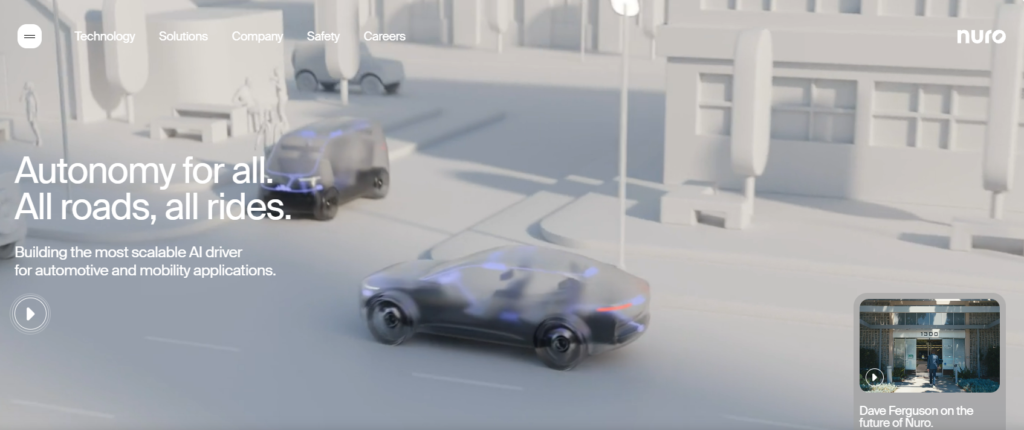
Source: Nuro
Nuro is redefining autonomy by focusing not on passengers but on packages. Instead of building robotaxis, Nuro builds small, self-driving delivery vehicles purpose-built for last-mile logistics. Its compact electric vehicles don’t have seats, steering wheels, or pedals. They’re designed to transport goods like groceries, prescriptions, and takeout.
Nuro holds over 600 patents and applications focused on autonomous navigation, collision avoidance, and vehicle design (source: USPTO and IFI CLAIMS, 2024). Backed by SoftBank, Google Ventures, and Tiger Global, it’s one of the few AV startups with regulatory approval and real-world commercial operations.
Industry Impact
Nuro is transforming last-mile delivery by partnering with brands like Domino’s, Kroger, and FedEx to deploy autonomous deliveries in suburban environments. Its vehicle design prioritizes safety for pedestrians and cyclists, making it ideal for urban and residential neighborhoods.
Key Innovations
Nuro R2: The Nuro R2 is a custom-built, fully autonomous delivery vehicle with no space for passengers, just packages. It’s small, low-speed, and electric, designed specifically for navigating residential streets and commercial zones safely. Its external design includes soft materials, pedestrian-friendly contours, and active safety systems to minimize harm in case of a collision.
Custom Electric Chassis: Nuro’s chassis is engineered from the ground up for delivery and is not retrofitted from a passenger car. It features a compact footprint for curbside navigation and temperature-controlled compartments to carry groceries, prescriptions, or takeout. The vehicle’s lightweight build and low top speed reduce risk while optimizing efficiency for short, repetitive routes.
Nuro Delivery Platform: The Nuro Delivery Platform integrates vehicle routing, fleet scheduling, remote support, and customer interactions into a single system. It allows partners like Domino’s, Kroger, and FedEx to manage and monitor deliveries end to end. The platform ensures seamless integration with retail systems, enabling scalable autonomous logistics.
#6. Zoox
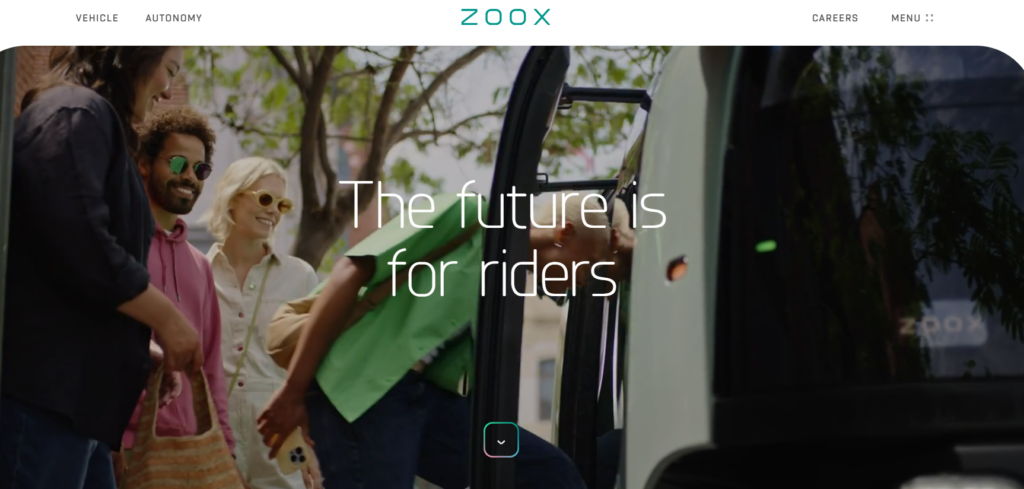
Source: Zoox
Zoox, acquired by Amazon in 2020, is building a fully autonomous vehicle from the ground up, not just retrofitting existing cars. Its robotaxi is a bi-directional, symmetrical, electric vehicle with no steering wheel or driver’s seat, designed for dense city environments. Every design choice reflects autonomy-first thinking, from the custom sensor architecture to the compact four-passenger layout.
Zoox has filed hundreds of patents in autonomous navigation, vehicle design, and environmental perception, and it’s one of the few companies building both the vehicle and the software in-house (source: USPTO filings and Zoox careers/IP updates, 2024). Backed by Amazon’s logistical muscle, Zoox has both technical depth and operational backing to scale fast.
Industry Impact
Zoox is transforming urban ride-hailing with a focus on safety, sustainability, and passenger experience. Its vehicle is purpose-built for autonomy, giving it a competitive edge in user-first robotaxi deployments, especially in crowded downtowns where traditional cars struggle.
Key Innovations
Zoox Robotaxi: The Zoox Robotaxi is a fully autonomous, bi-directional electric vehicle built from scratch. There’s no steering wheel, pedals, or front or back. It’s designed for urban mobility with a compact footprint, all-wheel steering, and four-wheel drive to navigate tight city streets. The vehicle offers a spacious, face-to-face seating layout to optimize comfort and social interaction during rides.
Symmetrical Design: Zoox’s symmetrical design means the vehicle can drive equally well in either direction, eliminating the need for U-turns or complex reversing maneuvers. This makes it exceptionally nimble in urban cores and congested intersections. Combined with advanced path planning, it enables safer, smoother navigation in environments where traditional cars struggle.
Custom AV Sensor Suite: Zoox has developed a proprietary sensor stack that combines LiDAR, radar, cameras, and thermal imaging for 360-degree situational awareness. This sensor fusion allows it to detect pedestrians, vehicles, and obstacles at various ranges, even in low-light or adverse weather. The suite is tightly integrated with Zoox’s onboard compute system, enabling real-time decision-making with redundancy for safety.
#7. Motional
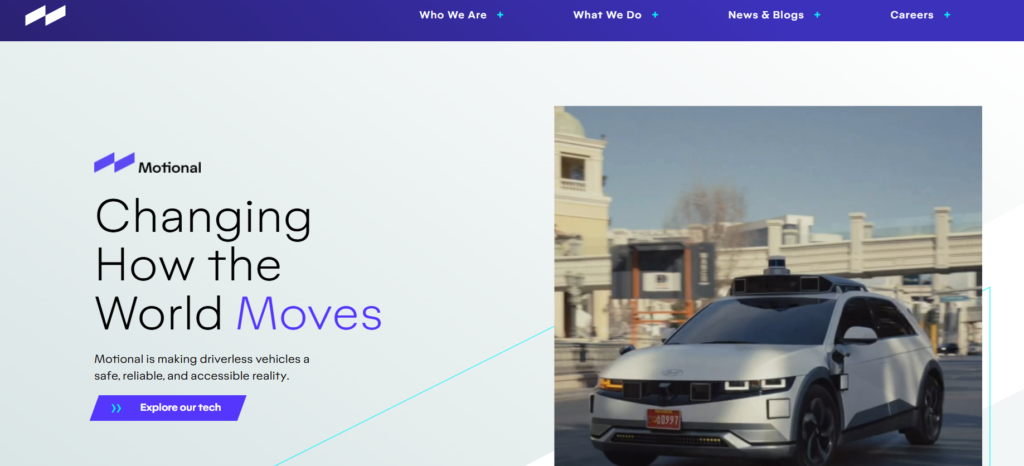
Source: Motional
Motional is a joint venture between Hyundai and Aptiv, focused on scaling robotaxis across major cities. With over a decade of AV research behind it (tracing back to Aptiv’s participation in DARPA challenges), Motional combines deep automotive manufacturing expertise with cutting-edge autonomy. It was among the first to offer public autonomous rides on Lyft’s platform and is now operating fully driverless vehicles in Las Vegas.
Motional holds over 300 active patents in AV software, simulation, and safety systems (source: IFI CLAIMS, 2024). It’s also among the few companies with driverless testing permits in the U.S. and Singapore, giving it an international edge.
Industry Impact
Motional is accelerating autonomous ride-hailing in partnership with platforms like Uber and Lyft. It also works closely with OEMs to integrate its tech into production-ready electric vehicles designed for autonomy at scale.
Key Innovations
AV Platform with Hyundai Ioniq 5: Motional integrates its autonomous technology into production-ready vehicles like the Hyundai Ioniq 5, enabling real-world deployments without custom-built vehicles. The system includes hardware and software designed to handle complex urban driving scenarios safely and reliably. By using an OEM vehicle, Motional accelerates scalability and cuts down manufacturing costs.
Safety-First AV Stack: The Safety-First AV Stack is designed with layered redundancies across perception, planning, and actuation systems. It ensures that if one subsystem fails, others can take over to maintain control and safety. This architecture is key to earning public trust and regulatory approval for driverless operations.
Real-Time Teleoperation System: Motional uses a remote assistance platform that allows trained operators to provide guidance in rare edge cases or unexpected road conditions. This system doesn’t take over driving but offers context-aware input to help the AV resolve uncertain scenarios. It acts as a safety net to support autonomy during transitional phases.
#8. Pony.ai
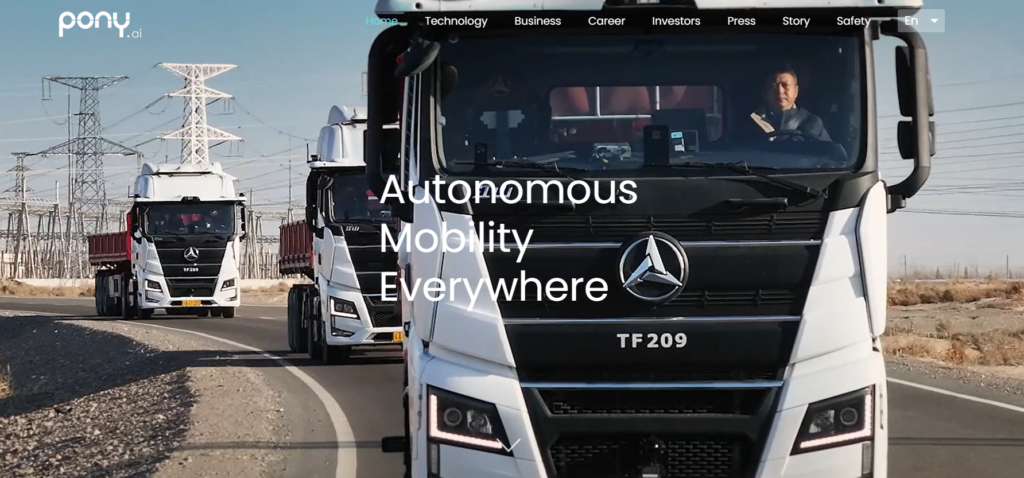
Source: Pony
Pony.ai is one of the few autonomous driving companies operating across both the U.S. and China, two of the most competitive and regulated markets in the world. Its strategy spans robotaxis and autonomous freight, with real-world pilots in cities like Beijing, Guangzhou, and Fremont. Backed by Toyota, Pony.ai strongly focuses on commercializing autonomy in complex, high-density urban environments.
The company holds more than 500 patents globally, covering areas like decision-making algorithms, multi-sensor fusion, and vehicle control systems (source: USPTO and Pony.ai press releases, 2024). Its cross-border R&D gives it a unique advantage in developing adaptable and scalable AV systems.
Industry Impact
Pony.ai is transforming passenger transport and logistics through robotaxi services, autonomous trucking pilots, and partnerships with major automotive manufacturers. Its dual-market presence makes it one of the most globally integrated players in the AV race.
Key Innovations
PonyPilot+: PonyPilot+ is the company’s commercial robotaxi service, operating in major cities across China and California. It features a mature autonomous stack capable of handling urban traffic, intersections, and unpredictable road behavior. Focusing on safety and ride experience, the service uses production vehicles outfitted with Pony.ai’s full AV hardware and software platform.
Autonomous Freight Division: Pony.ai has expanded its AV stack to freight through its autonomous trucking program, targeting high-demand logistics routes. These vehicles are built to handle long-haul, high-speed driving with a focus on fuel efficiency and driver safety. The freight platform leverages the same core software as the robotaxi service, optimized for different vehicle dynamics and highway scenarios.
Dual-Market Operating System: Pony.ai’s operating system is designed to meet both U.S. and Chinese regulatory and infrastructural demands, making it one of the few AV companies with true cross-border scalability. It supports multilingual interfaces, local mapping systems, and jurisdiction-specific compliance features. This adaptability gives Pony.ai a unique edge in global deployment readiness.
#9. AutoX
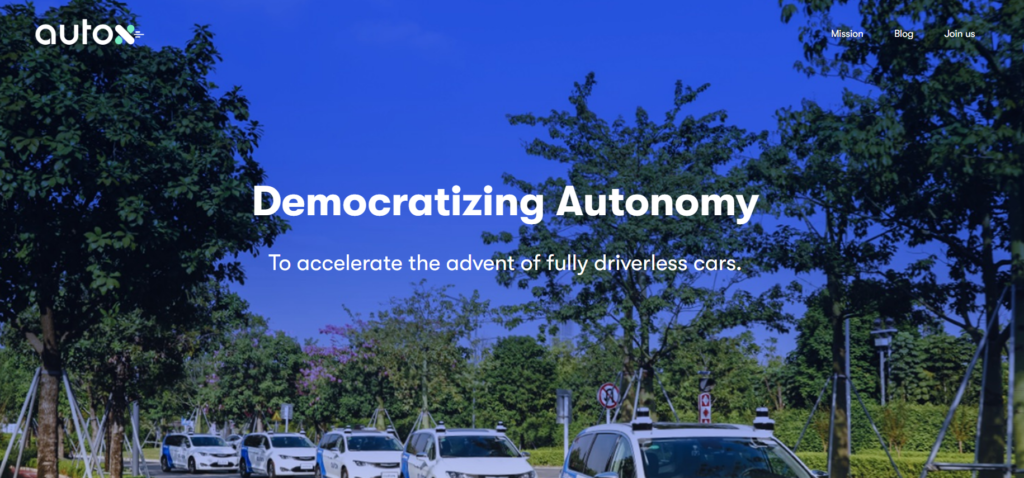
Source: AutoX
AutoX is the first company to operate a fully driverless robotaxi fleet in China without safety drivers. Headquartered in Shenzhen and backed by Alibaba, AutoX is focused on building scalable, Level 4 autonomous technology tailored for urban Chinese megacities. Its vehicles have navigated complex traffic scenarios like jaywalkers, scooters, and unregulated intersections without human intervention.
AutoX has filed over 1,000 patents on autonomous navigation, real-time sensor fusion, and vehicle control systems (source: CNIPA and company filings, 2024). It also runs the largest autonomous driving data center in China, helping accelerate AI training and simulation at scale.
Industry Impact
AutoX is transforming urban mobility in Asia through robotaxi deployments across cities like Shenzhen, Guangzhou, and Shanghai. By combining deep localization with global engineering talent, it’s quickly becoming one of China’s AV powerhouses.
Key Innovations
AutoX Gen5 AV Platform: AutoX Gen5 is a Level 4 autonomous platform equipped with over 50 sensors, including ultra-wide 4D LiDAR, HD cameras, and high-performance radar. It’s designed for dense urban environments and can handle complex situations like merging in tight traffic or navigating through unregulated intersections. The system operates entirely without a safety driver and is already deployed in fully driverless fleets in China.
China-Scale AV Data Center: AutoX runs one of the largest autonomous driving data centers in China, processing petabytes of sensor data to improve AI models continuously. This infrastructure allows for rapid iteration and training of edge-case scenarios, which are then pushed back to vehicles in the fleet. It’s a key enabler for fast software updates and real-time system learning at the national scale.
Hybrid Simulation + Real-World Feedback Loop: AutoX combines virtual testing with real-world driving data to create a continuous feedback loop for system improvement. Simulated scenarios are crafted from actual edge cases its fleet encounters, enabling safe testing and rapid software validation. This hybrid model balances safety, speed, and scalability in AV development.
#10. Baidu Apollo
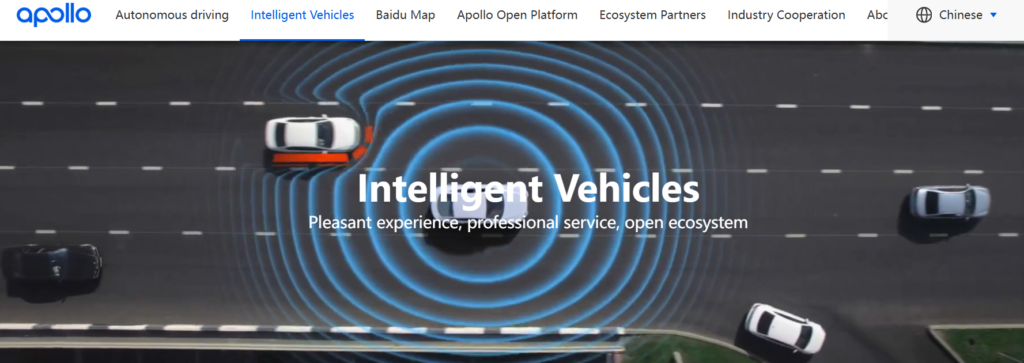
Source: Apollo
Baidu’s Apollo project is China’s most advanced and government-backed autonomous driving initiative. Unlike most competitors, Apollo is a platform-first ecosystem, offering open-source AV software, HD maps, and AI driving models to automakers and mobility providers. Baidu operates Apollo Go, a commercial robotaxi service already in over 10 Chinese cities, including a fully driverless service in Wuhan and Chongqing.
With over 3,000 patents in autonomous driving, Baidu is the most prolific AV patent filer in China (source: CNIPA and Baidu IR, 2024). It’s also the only AV company in China with national-level permits for driverless commercial operation, making it a strategic leader in shaping the country’s autonomous mobility infrastructure.
Industry Impact
Baidu Apollo is transforming public transport and smart city logistics. From robotaxis to autonomous buses and street-cleaning vehicles, Apollo is embedding autonomy into China’s mobility fabric nationally.
Key Innovations
Apollo Go: Apollo Go is Baidu’s commercial robotaxi service, the largest of its kind in China, and it already operates in over 10 cities. It has achieved full driverless status in cities like Wuhan and Chongqing, with no safety driver onboard. The service seamlessly integrates with Baidu Maps and other local apps, enabling mass-market adoption through everyday user platforms.
Apollo RT6: The Apollo RT6 is a Level 4-ready electric vehicle designed specifically for autonomous operation, featuring a removable steering wheel. It’s built for high-volume production and offers a spacious, customizable interior for robotaxi services. By controlling both the vehicle design and AV software, Baidu can optimize performance, safety, and user experience.
Open AV Stack for OEMs: Baidu offers its autonomous driving stack as a modular platform to automakers across China. This open ecosystem allows OEMs to integrate Baidu’s perception, planning, and control modules into their vehicles. It positions Apollo as not just a mobility service but a foundational layer for the country’s AV industry.
#11. WeRide
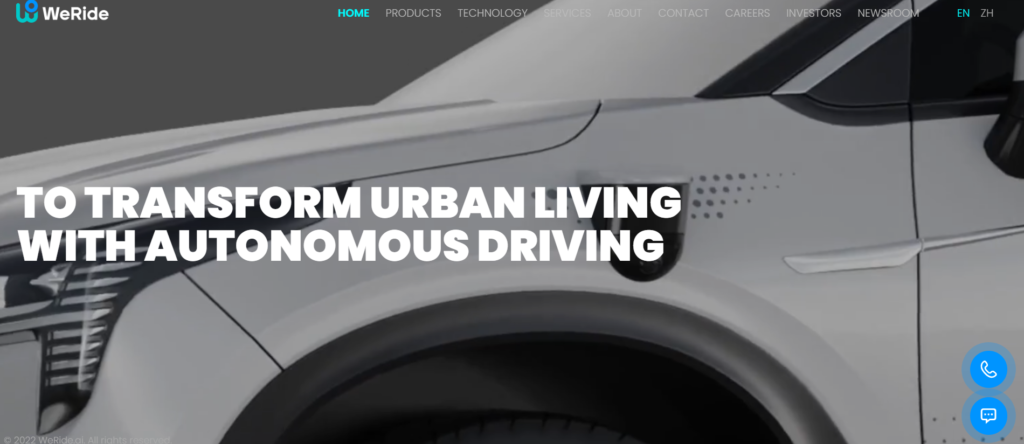
Source: WeRide
WeRide is one of the few autonomous driving companies in China operating across multiple verticals, robotaxis, autonomous buses, and autonomous street sweepers. Headquartered in Guangzhou, WeRide focuses on developing Level 4 autonomous tech optimized for dense urban environments. It was among the first to receive a permit to test fully driverless vehicles on public roads in China without safety drivers.
WeRide holds over 500 patents globally (source: CNIPA and company disclosures, 2024), with strong R&D in multi-modal sensor integration and edge-based decision-making. Backed by Nissan, Renault, and Bosch, it’s positioned as a full-stack AV company with a strong commercial rollout roadmap.
Industry Impact
WeRide is redefining city operations, not just mobility. Its AVs support public transit, street cleaning, and logistics in high-density zones, creating an ecosystem where autonomy powers more than just passenger transport.
Key Innovations
WeRide Robotaxi: WeRide’s robotaxi operates in multiple Chinese cities and is built to navigate chaotic urban traffic with pedestrians, scooters, and complex intersections. It combines LiDAR, radar, and camera data using a multi-sensor fusion approach for high-resolution perception. The system is already licensed for fully driverless testing, positioning WeRide among the few AV companies operating without safety drivers.
WeRide Robobus: The Robobus is a medium-sized autonomous shuttle designed for city-scale public transportation. It runs fixed routes and supports high passenger volume, targeting use cases like business parks, airports, and city centers. The vehicle is electric, driverless, and equipped with redundant systems to ensure safety in high-density environments.
Autonomous Street Sweeper: WeRide has extended its AV capabilities into municipal services with its autonomous street sweeper. The vehicle is built to operate safely in narrow lanes and around pedestrians, handling repetitive cleaning routes without human intervention. This marks a unique pivot from mobility to infrastructure automation, broadening WeRide’s impact.
#12. Navya
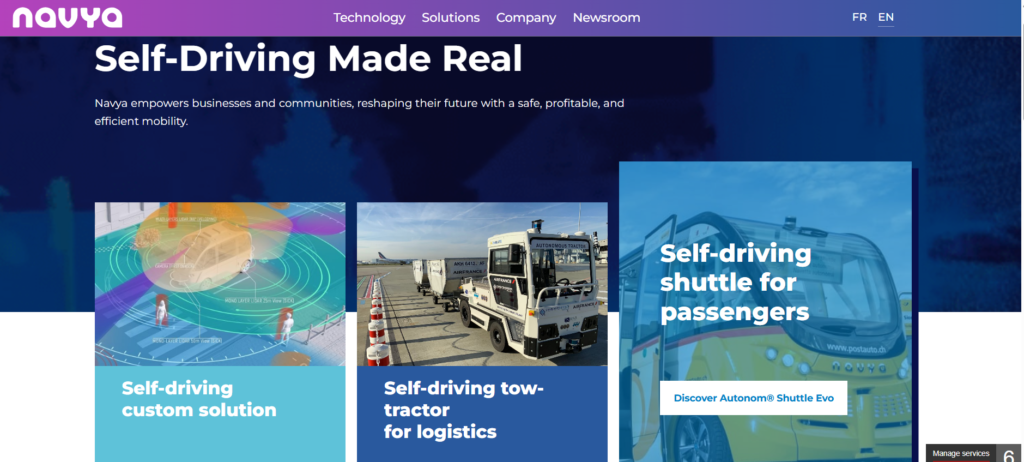
Source: Navya
Navya, based in France, is one of the pioneers in autonomous shuttles for public and private transport campuses. Rather than focusing on personal vehicles or robotaxis, Navya designs electric, driverless shuttles built for fixed routes, like business parks, hospitals, airports, and university campuses. These vehicles are fully autonomous at low speeds and already operate across Europe, the U.S., and Asia.
Navya has filed over 100 patents, primarily around vehicle automation, fleet coordination, and sensor integration (source: EPO and Navya filings, 2024). While it doesn’t chase high-speed autonomy, its deep expertise in controlled-environment AV deployment makes it a go-to partner for structured mobility use cases.
Industry Impact
Navya is transforming first-mile and last-mile transport in closed-loop environments. Its autonomous shuttles help reduce emissions and improve accessibility in smart cities, campuses, and business districts.
Key Innovations
Autonom® Shuttle Evo: The Autonom® Shuttle Evo is a fully autonomous, electric shuttle designed to transport up to 15 passengers without a driver, steering wheel, or pedals. Equipped with advanced guidance and detection systems, including LiDAR sensors, cameras, GPS RTK, IMU, and odometry, it effectively navigates complex environments by processing real-time data to make informed driving decisions. This shuttle offers a sustainable and efficient solution for first- and last-mile transportation in urban areas and private sites.
Navya Drive®: Navya Drive® is the proprietary software that powers Navya’s autonomous vehicles, comprising three core modules: Perception, Decision, and Action. The Perception module interprets data from various sensors to understand the vehicle’s surroundings, the Decision module determines the appropriate responses to environmental inputs, and the Action module executes the driving commands. This integrated software architecture enables safe and efficient autonomous navigation across diverse scenarios.
Fleet Management and Supervision Services: Navya provides comprehensive fleet management tools and supervision services to optimize the operation of its autonomous shuttles. These services include real-time vehicle monitoring, predictive maintenance, and data analytics to enhance performance and reliability. By offering 24/7 maintenance and support, Navya ensures the seamless integration of autonomous shuttles into existing transportation networks, thereby improving productivity and reducing urban congestion.
#13. Oxbotica
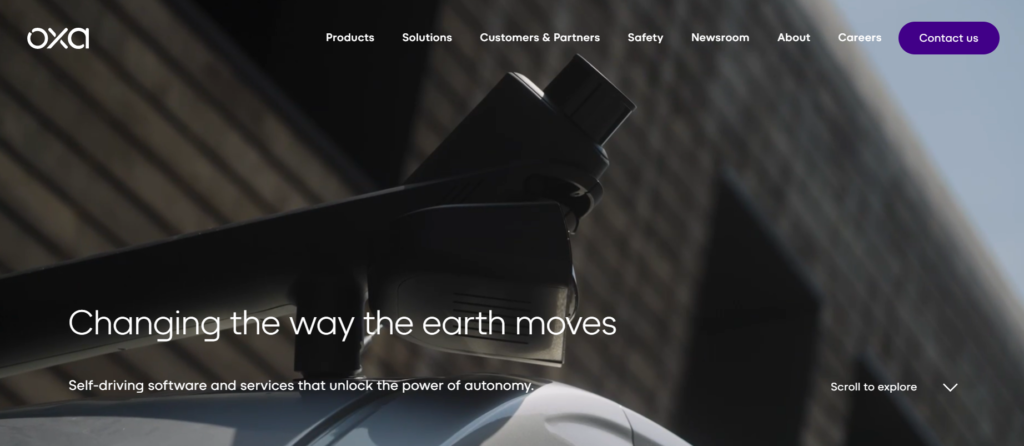
Source: Oxa
Oxbotica is building a vehicle-agnostic autonomy platform designed to power everything from delivery vans and shuttles to off-road mining and agricultural equipment. Based in the UK, its core advantage is flexibility; its software can be plugged into almost any vehicle type, regardless of size or function.
Oxbotica holds 200+ patents and filings in localization, perception, and cloud-based fleet orchestration (source: UKIPO and company data, 2024). Its partnership with companies like ZF, BP, and Ocado demonstrates the platform’s cross-sector traction and real-world viability across industrial and urban use cases.
Industry Impact
Oxbotica is transforming logistics, mining, and industrial mobility by offering plug-and-play autonomy for fleets that need to operate safely in both structured and unstructured environments.
Key Innovations
Universal Autonomy Platform: Oxbotica’s Universal Autonomy platform is a versatile, full-stack software solution that enables autonomous operation across various vehicle types and environments. This platform-agnostic system allows for seamless integration into different industries, including automotive, mining, and logistics, facilitating the deployment of self-driving technology in both on-road and off-road scenarios. Eliminating reliance on external infrastructure like GPS ensures robust performance even in challenging conditions.
Oxbotica Driver: Oxbotica Driver is the core autonomy system that processes sensor data for safe and efficient vehicle operation. It is designed to function across various vehicle platforms, including industrial vehicles, mining trucks, shuttles, and last-mile delivery vans. By interpreting data from sensors such as LiDAR, radar, and cameras, Oxbotica Driver allows vehicles to navigate complex environments without human intervention.
#14. Kodiak Robotics
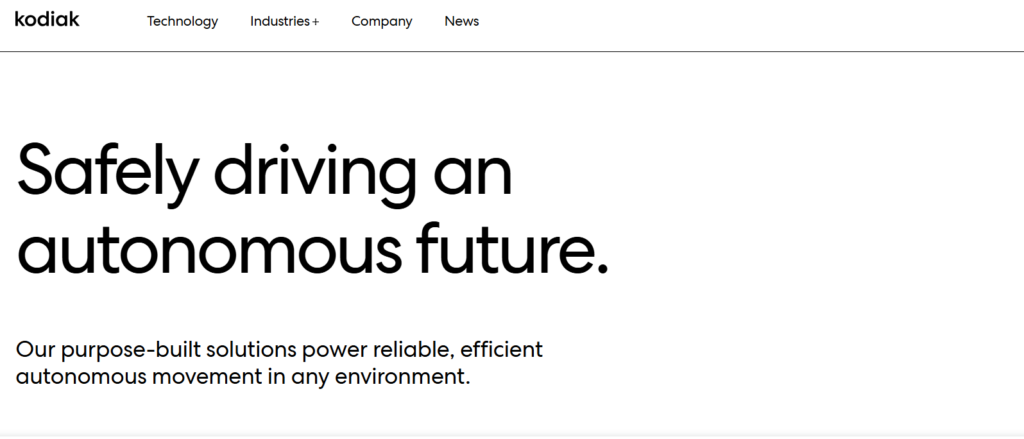
Source: Kodiak
Kodiak Robotics is tackling one of the most commercially viable AV segments: long-haul trucking. Its modular autonomy stack is designed for integration into existing trucks with minimal hardware changes, speeding up adoption across fleet operators.
The company has filed over 100 patents focused on autonomous highway driving, sensor calibration, and fallback safety systems (source: USPTO and company press, 2024). Kodiak has also formed active freight partnerships and regularly moves commercial loads on major U.S. routes.
Industry Impact
Kodiak is transforming freight logistics by enabling scalable, autonomous trucking that improves fuel efficiency, reduces driver shortages, and increases operational uptime for logistics providers.
Key Innovations
The Kodiak Driver: The Kodiak Driver is an advanced autonomous driving system designed to be modular and adaptable across various vehicle platforms. It integrates cutting-edge AI with purpose-built hardware to provide 360-degree visibility and real-time decision-making capabilities. This system is engineered for easy integration, maintenance, and operation in diverse environments, enhancing safety and efficiency in autonomous transportation.
SensorPods: Kodiak’s SensorPods are streamlined, modular sensor units that house cameras, LiDARs, and radars, providing the Kodiak Driver with comprehensive environmental awareness. Designed for quick field replacement, these SensorPods can be swapped out in as little as 10 minutes, minimizing downtime and maintenance complexity. This design enhances the reliability and serviceability of autonomous vehicles equipped with the Kodiak Driver.
Redundant Safety Systems: Kodiak’s autonomous vehicles are equipped with redundant steering, braking, and power systems to ensure safety in the event of a component failure. These backup systems are designed to seamlessly take over if the primary system encounters an issue, allowing the vehicle to maintain control and come to a safe stop if necessary. This redundancy is crucial for safely deploying driverless vehicles on public roads.
#15. Vay
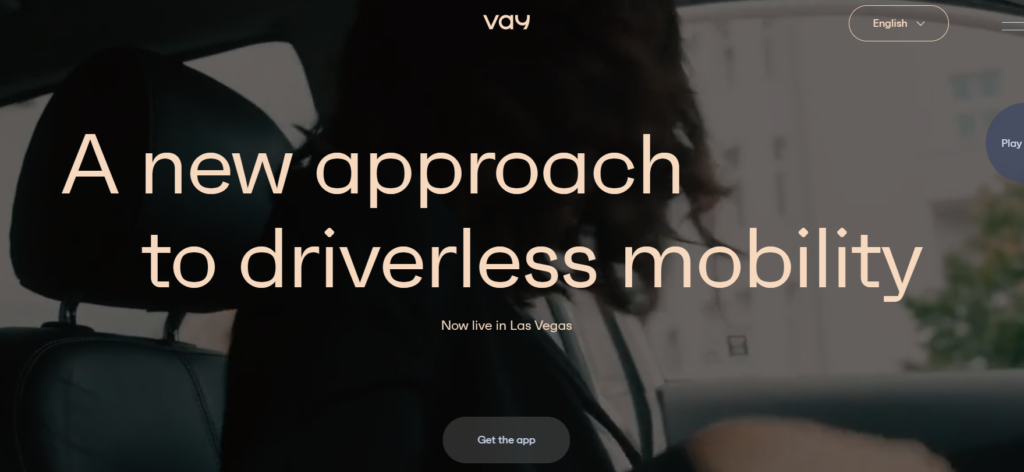
Source: Vay
Vay is pioneering a “teledriving” model, where cars are remotely operated by trained drivers from a command center. It’s a legal, scalable bridge between today’s human-driven cars and tomorrow’s fully autonomous fleets, already approved for commercial deployment in Germany.
Vay’s approach allows for rapid rollout while collecting real-world driving data to power full autonomy eventually. It holds patents related to remote control, latency minimization, and safety protocols (source: EUIPO and company reports, 2024).
Industry Impact
Vay is redefining vehicle delivery and rental logistics by enabling cars to arrive without a driver, which is ideal for short-term rentals, fleet repositioning, or consumer vehicle delivery.
Key Innovations
Teledriving Technology: Vay’s teledriving technology enables professionally trained drivers to operate vehicles remotely from a centralized teledrive station. Equipped with a steering wheel, pedals, and monitors, these stations replicate the in-car experience by transmitting real-time data from the vehicle’s sensors and cameras. This setup allows the teledriver to control the vehicle on public roads without being physically present inside, combining human decision-making with remote operation to navigate complex urban environments safely.
Driverless Mobility Service: Vay has launched a commercial driverless mobility service in Las Vegas, offering a unique approach where vehicles are remotely delivered to users. After the teledriver brings the car to the user’s location, the user drives themselves to their destination. Upon completion, the teledriver remotely parks the vehicle or directs it to the next user. This service provides a cost-effective, convenient, and sustainable transportation option, eliminating the need for users to search for parking or visit rental locations.
Safety and Compliance Standards: Vay prioritizes safety by adhering to rigorous automotive industry standards, including functional safety (ISO 26262) and cybersecurity (ISO 21434). The company’s technology has been tested and positively endorsed by TÜV Süd, an independent third-party certification organization. Vay’s teledrivers undergo comprehensive training through the Vay Teledrive Academy, ensuring they operate vehicles with a safe and defensive driving style, thereby maintaining high safety standards during remote operations.
#16. DeepRoute.ai
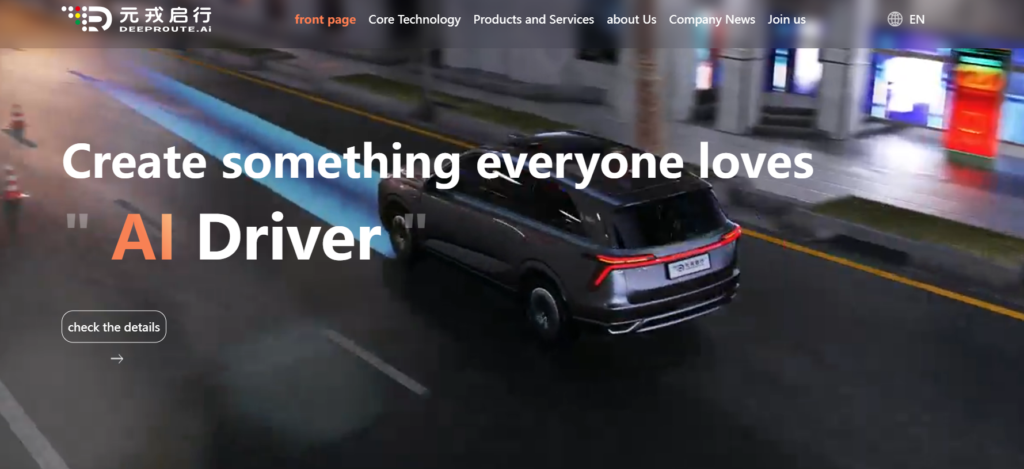
Source: DeepRoute
DeepRoute.ai is developing a low-cost, production-ready, full-stack autonomous driving system for rapid OEM integration. Its solution combines sensors, compute, and AI into a unified system called DeepRoute-Driver 3.0, optimized for city-level robotaxi deployment.
The company has filed over 300 patents in perception, planning, and cost-optimized AV hardware (source: CNIPA and DeepRoute disclosures, 2024). Its partnerships with major Chinese automakers underscore its focus on real-world rollout over R&D-only innovation.
Industry Impact
DeepRoute.ai transforms urban transportation by making AV tech accessible and scalable, especially in price-sensitive, high-density markets.
Key Innovations
AI Spark Platform: DeepRoute.ai’s AI Spark platform extends beyond automotive applications to develop a “road brain” system, aiming for RoadAGI, artificial general intelligence for roads. This platform empowers various moving objects with autonomous navigation capabilities, utilizing a Vision-Language-Navigation model that processes natural language instructions and navigates without relying on high-definition maps. By seamlessly integrating indoor and outdoor environments, AI Spark facilitates safe and flexible interactions across diverse scenarios.
Vision-Language-Action (VLA) Model: The VLA model combines visual perception, language understanding, and action execution, enabling the smart driving system to recognize and describe the road environment, traffic signs, and participants. It comprehends complex scenarios, such as negotiations and hidden semantic information, with advanced logical reasoning capabilities. This human-like understanding enhances safety and efficiency in autonomous driving by allowing the system to handle intricate driving tasks effectively.
End-to-End Autonomous Driving Solution: DeepRoute.ai offers a production-ready Level 4 autonomous driving system priced at approximately $10,000, making advanced self-driving technology more accessible. This system includes solid-state LiDAR sensors, cameras, and a proprietary computing platform integrated with an inference engine. By combining perception, prediction, planning, and control into a unified neural network, the system learns and iterates from extensive data, enabling vehicles to navigate complex urban environments safely and efficiently.
Autonomous Vehicles Are Rewiring the Future of Transportation. What’s Next?
The 16 companies featured here are doing more than building self-driving tech; they’re reimagining how people and goods move through the world. From Waymo’s fully driverless robotaxis to Oxbotica’s universal autonomy platform and Kodiak’s highway-hardened trucking stack, these innovators are solving some of the hardest problems in mobility and AI.
But in a space moving this fast, how do we distinguish real innovation from vaporware?
Patent intelligence offers a crucial signal. It shows which problems companies are truly investing in, where defensible innovation is happening, and how different players approach autonomy, from sensors to simulation to control systems.

That’s where the Global Patent Search Tool comes in. This AI-powered tool helps you:
1. Discover related patents by describing your own autonomous vehicle idea.
2. Identify technologies by priority date and innovation timeline.
3. Match specific features of AV systems to existing patents.
4. Analyze how autonomous mobility is evolving across industries.
Whether you’re a mobility strategist, researcher, or investor, understanding the patent landscape behind AVs means staying ahead of the next breakthrough.
Want to see who’s really shaping the future of driverless technology? Start exploring with the Global Patent Search Tool today.

